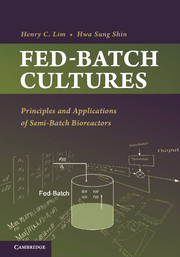Book contents
- Frontmatter
- Contents
- Preface
- Acknowledgments
- 1 Introduction to Fed-Batch Cultures
- 2 Idealized Reactors and Fed-Batch Reactors
- 3 Maximization of Reaction Rates and Fed-Batch Operation
- 4 Phenomena That Favor Fed-Batch Operations
- 5 Classification and Characteristics of Fed-Batch Cultures
- 6 Models Based on Mass Balance Equations
- 7 Non–Equation-Based Models
- 8 Specific Rate Determination
- 9 Optimization by Pontryagin's Maximum Principle
- 10 Computational Techniques
- 11 Optimization of Single and Multiple Reactions
- 12 Optimization for Cell Mass Production
- 13 Optimization for Metabolite Production
- 14 Simple Adaptive Optimization
- 15 Measurements, Estimation, and Control
- 16 Feasibility Assessment and Implementable Feed Rates
- Index
16 - Feasibility Assessment and Implementable Feed Rates
Published online by Cambridge University Press: 05 April 2013
- Frontmatter
- Contents
- Preface
- Acknowledgments
- 1 Introduction to Fed-Batch Cultures
- 2 Idealized Reactors and Fed-Batch Reactors
- 3 Maximization of Reaction Rates and Fed-Batch Operation
- 4 Phenomena That Favor Fed-Batch Operations
- 5 Classification and Characteristics of Fed-Batch Cultures
- 6 Models Based on Mass Balance Equations
- 7 Non–Equation-Based Models
- 8 Specific Rate Determination
- 9 Optimization by Pontryagin's Maximum Principle
- 10 Computational Techniques
- 11 Optimization of Single and Multiple Reactions
- 12 Optimization for Cell Mass Production
- 13 Optimization for Metabolite Production
- 14 Simple Adaptive Optimization
- 15 Measurements, Estimation, and Control
- 16 Feasibility Assessment and Implementable Feed Rates
- Index
Summary
In previous chapters on optimization, we saw that once a process model in the form of mass balance equations is developed, it can be optimized using, among other methods, Pontryagin's maximum principle (PMP), or when a statistical model such as a neural network model is available, it can be optimized using a method of optimization that is most appropriate for the model.
As discussed in Chapter 4, various physical and chemical phenomena favor fed-batch operations. For physical reasons, such as the need to use auxotrophic mutants, attainment of high cell and metabolite concentrations, and alleviation of high viscosity, the use of fed-batch is obvious and intuitive, whereas for chemical reasons, such as substrate inhibition, glucose effects, and catabolite repressions, the use of fed-batch operation requires recognition of nonmonotonic specific rates such as cell growth, substrate consumption, and product formation, μ, σ, and π. In other words, at least one of the specific rates must exhibit a maximum with respect to the substrate concentration.
- Type
- Chapter
- Information
- Fed-Batch CulturesPrinciples and Applications of Semi-Batch Bioreactors, pp. 437 - 452Publisher: Cambridge University PressPrint publication year: 2013



